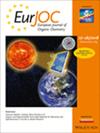促进极性天然产物的分离:温和的1,1 ' -羰基二咪唑-激活方法用于酸和醇的衍生化
IF 2.5
3区 化学
Q2 CHEMISTRY, ORGANIC
引用次数: 0
摘要
许多含有羧酸和醇官能团的次生代谢物具有高度极性,难以从天然来源的复杂提取物中纯化和分离。这些天然产物在温和的条件下转化为相应的烷基酯/碳酸酯,可以简化它们的纯化和分离。然而,传统的衍生化方法通常依赖于有毒和/或腐蚀性试剂,在某些情况下也可能导致副产物的形成或外聚化。在这项工作中,1,1 ' -羰基二咪唑(CDI)是一种相对便宜且具有低毒性的试剂,用于激活含有羧酸和醇的极性天然产物,以形成极性较小的物种(N -酰基咪唑和N -酰基咪唑)。这些中间体用甲醇处理后很容易转化为甲酯和碳酸盐。期望这种简单而通用的衍生化方法能有效分离含极性羧酸和醇残基的次生代谢物。本文章由计算机程序翻译,如有差异,请以英文原文为准。
Facilitating the Isolation of Polar Natural Products: Mild 1,1’‐Carbonyldiimidazole‐Enabled Method for Derivatization of Acids and Alcohols
Many secondary metabolites containing carboxylic acid and alcohol functional groups are highly polar and can be difficult to purify and isolate from complex extracts obtained from natural sources. The conversion of these natural products to their corresponding alkyl esters/ carbonates under mild conditions can simplify their purification and isolation. However, traditional derivatization methods have often relied on toxic and/ or corrosive reagents that can also lead to byproduct formation or epimerization in some instances. In this work, 1,1′‐carbonyldiimidazole (CDI), a relatively inexpensive reagent with inherently low toxicity, is utilized to activate polar natural products containing carboxylic acids and alcohols to enable the formation of less polar species (N‐acylimidazoles and N‐acyloxymidazoles). These intermediates are readily converted into methyl esters and carbonates by treatment with methanol. It is anticipated that this rather simple and versatile derivatization method can facilitate the efficient isolation of secondary metabolites bearing polar carboxylic acid and alcohol residues.
求助全文
通过发布文献求助,成功后即可免费获取论文全文。
去求助
来源期刊
CiteScore
5.40
自引率
3.60%
发文量
752
审稿时长
1 months
期刊介绍:
The European Journal of Organic Chemistry (2019 ISI Impact Factor 2.889) publishes Full Papers, Communications, and Minireviews from the entire spectrum of synthetic organic, bioorganic and physical-organic chemistry. It is published on behalf of Chemistry Europe, an association of 16 European chemical societies.
The following journals have been merged to form two leading journals, the European Journal of Organic Chemistry and the European Journal of Inorganic Chemistry:
Liebigs Annalen
Bulletin des Sociétés Chimiques Belges
Bulletin de la Société Chimique de France
Gazzetta Chimica Italiana
Recueil des Travaux Chimiques des Pays-Bas
Anales de Química
Chimika Chronika
Revista Portuguesa de Química
ACH—Models in Chemistry
Polish Journal of Chemistry.

 求助内容:
求助内容: 应助结果提醒方式:
应助结果提醒方式:


